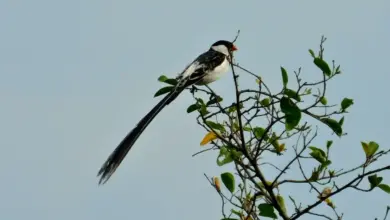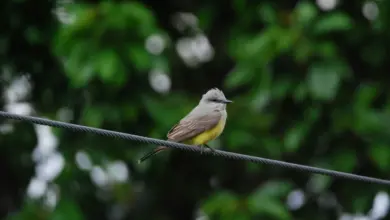Southern Cassowary aka Double-wattled Cassowary
Southern Cassowary aka Double-wattled Cassowary, Australian Cassowary or Two-wattled Cassowary
Cassowaries … Ratites
The Southern Cassowary, Casuarius casuarius, also known as Double-wattled Cassowary, Australian Cassowary or Two-wattled Cassowary, is a large flightless black bird. It is a ratite and therefore closely related to the emu, Ostrich, and Rhea.
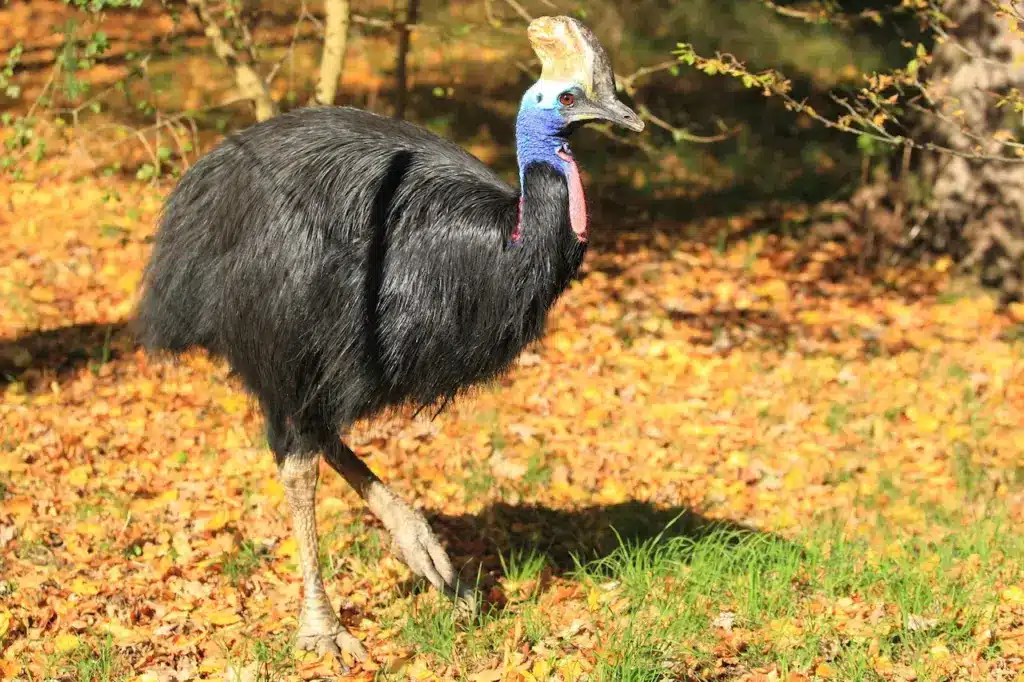
Description
It has hard and stiff plumage, a brown casque, blue face and neck, red nape and two red wattles hanging down its throat. The three-toed feet are thick and powerful, equipped with a lethal dagger-like claw up to 12 cm (4.7 in) on the inner toe. The plumage is sexually monomorphic, but the female is dominant and larger with a longer casque and brighter-colored bare parts. The immature bird has plain brown plumage. It is the largest member of the cassowary family and is the second heaviest bird on earth, at a maximum size estimated at 85 kilograms (190 lb) and 190 centimetres (75 in). Normally this species ranges from 127 to 170 centimetres (50–67 in), with females averaging 58 kilograms (130 lb) and males averaging 29 to 34 kilograms (64–75 lb). It is technically the largest Asian bird (since the extinction of the Arabian Ostrich, and previously the Moa of New Zealand) and the largest Australian bird (though the Emu may be slightly taller).
Range and habitat
The Southern Cassowary is distributed in tropical rainforests of Aru and Seram Islands of Indonesia, New Guinea and northeastern Australia, and it prefers elevations below 1,100 m (3,600 ft) in Australia, and 500 m (1,600 ft) on New Guinea.
Behavior
It forages on the forest floor for fallen fruit and is capable of safely digesting some fruits toxic to other animals, particularly the cassowary fruit. They also eat fungi, and some insects and small vertebrates. The Southern Cassowary is a solitary bird, that pairs only in breeding season, which takes place in late winter or spring. The male builds a nest on the ground; a mattress of herbaceous plant material 5 to 10 centimetres (2–4 in) thick and up to 100 centimetres (39 in) wide. This is thick enough to let moisture drain away from the eggs. It is situated in a sheltered area among tall grass or similar cover. He also incubates the eggs and raises the chicks. A clutch of three or four eggs are laid measuring 138 by 95 millimetres (5.4 in × 3.7 in). They have a granulated surface and are initially bright pea-green in colour although they fade with age.
They make a booming call during mating season and hissing and rumblings otherwise. Chicks will make frequent high-pitches whistles to call the male.
The blade-like claws are capable of killing humans and dogs if the bird is provoked.
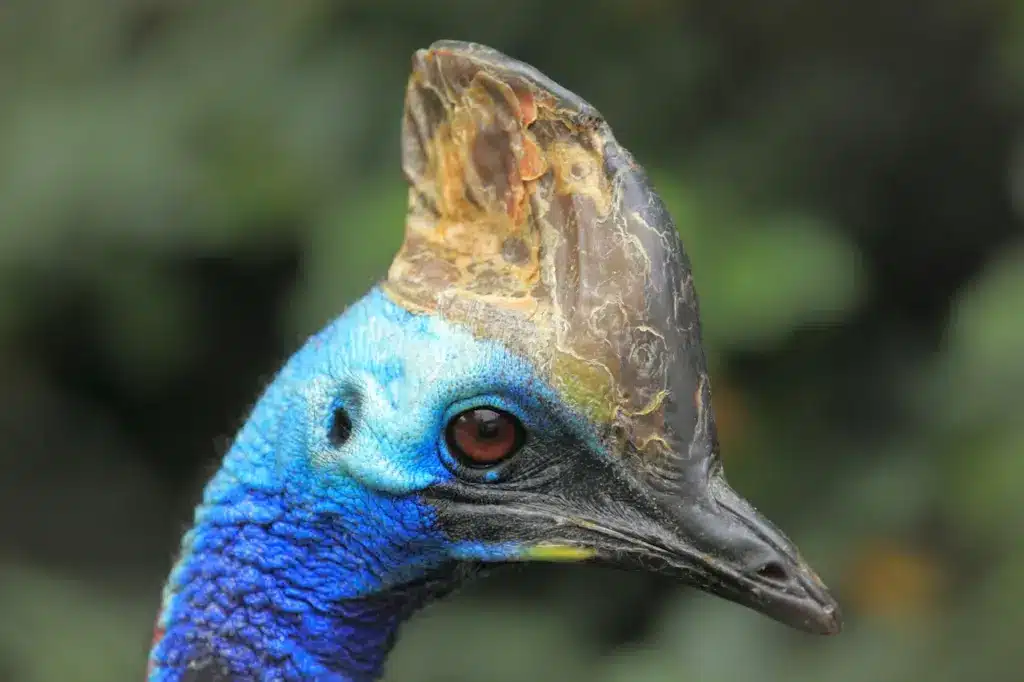
Conservation
Due to ongoing habitat loss, limited range and overhunting in some areas, the Southern Cassowary is evaluated as Vulnerable on the IUCN Red List of Threatened Species. Some threats are through habitat loss (logging), feral animals eating their eggs, hunting, and roadkill. Road building, feral animals and hunting are the worst of these threats. It has an occurrence range of 396,000 km2 (153,000 sq mi), and between 10,000 and 20,000 birds were estimated in a 2002 study, with between 1,500 and 2,500 in Australia.
| Location | Population | Trend |
| Southern Papua New Guinea | unknown | Declining |
| Seram | Unknown | Unknown |
| Aru Islands | Unknown | Unknown |
| Northeastern Australia | 1,500 to 2,500 | Declining |
| **Paluma Range | Unknown | Declining |
| **McIlwraith Range | 1000+ | Declining |
| **Jardine River National Park | Unknown | Unknown |
| Total | 2,500+ | Declining |
Taxonomy
Presently, most authorities consider the Southern Cassowary monotypic, but several subspecies have been described. It has proven very difficult to confirm the validity of these due to individual variations, age-related variations, the relatively few available specimens (and the bright skin of the head and neck – the basis of which several subspecies have been described – fades in specimens), and that locals are known to have traded live cassowaries for hundreds, if not thousands, of years, some of which are likely to have escaped/been deliberately introduced to regions away from their origin.
Cassowaries, of the family Casuariidae, are closely related to the kiwis in the family Apterygidae, with these two bird families diverging from a common ancestor 40 million years ago. The Southern Cassowary is in the class Aves, which includes all birds; those that can fly as well as those that cannot. The Aves, and thus the Southern Cassowary, share a common ancestor with snakes, lizards, iguanas and crocodiles. They aren’t very closely related however with the common ancestor’s divergence dating back 251 million years ago.
Their binomial name Casuarius casuarius is derived from the Malay word kesuari, meaning cassowary. The Southern Cassowary was first described by Carolus Linnaeus in his 18th century work, Systema Naturae, as Struthio casuarius, from a specimen from Seram, in 1758. It is now the type species of the genus Casuarius.
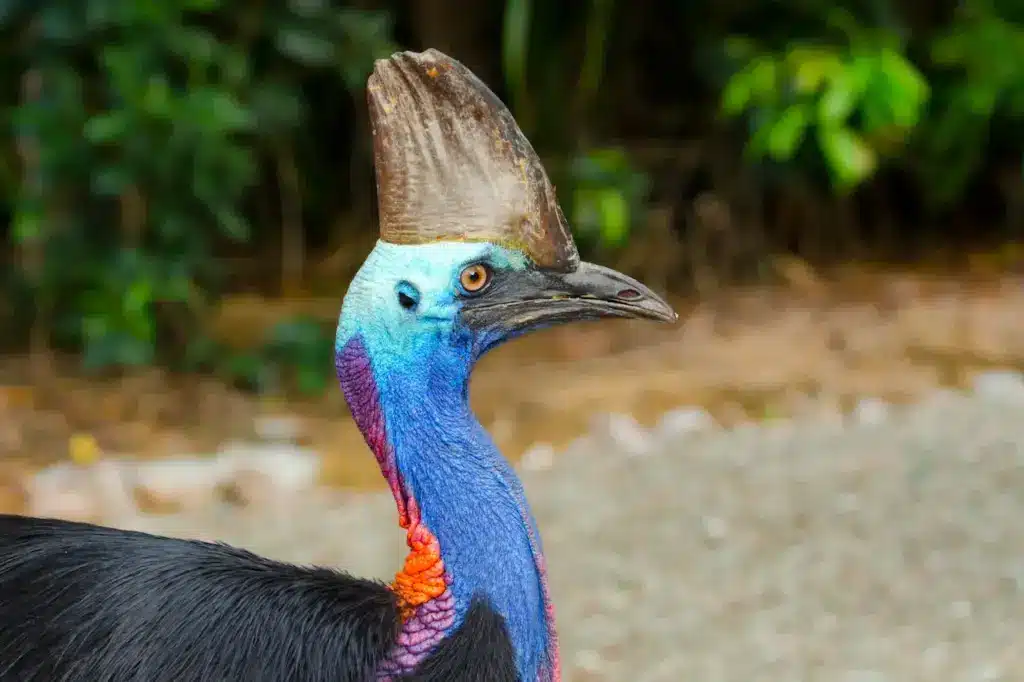
Homologous features
Although cassowaries cannot fly, the structure of their vestigial wings are homologous to the forearms of all pentadactyl animals. These animals include birds of flight, bats, whales and even humans. All of these animals’ upper limbs feature the same basic bone structure as that of a cassowary’s wing. Even though the functions are completely different, the similarities of these structures are evidence that all of these animals have evolved from a common ancestor at some stage. These homologous structures, as well as homologous features in other animals, are the result of divergent evolution also known as adaptive divergence.
Copyright: Wikipedia. This article is licensed under the GNU Free Documentation License. It uses material from the Wikipedia.org.
Photo gallery
Please Note: The articles or images on this page are the sole property of the authors or photographers. Please contact them directly with respect to any copyright or licensing questions. Thank you.


